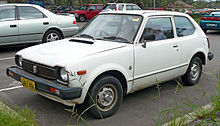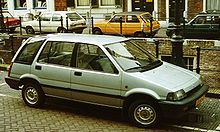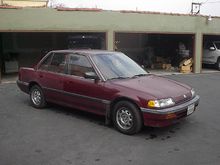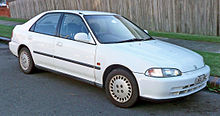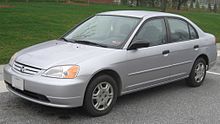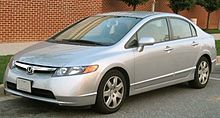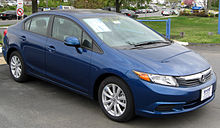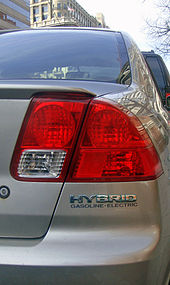- Honda Civic
-
Honda Civic 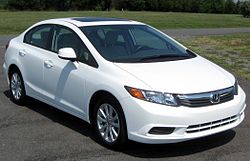
Manufacturer Honda Predecessor Honda N360
Honda Z600Class Subcompact car (1973–2000)
Compact car (2001–present)Related Acura EL
Acura CSX
Honda Ballade
Honda Civic Hybrid
Honda Civic GX
Honda Civic Type R
Honda Civic GTi
Honda Civic Si
Honda City
Honda Civic VTi
Honda Civic Vi-Rs
Honda Civic Vi
Honda Civic Type S
Rover 200 / 25The Honda Civic is a line of subcompact and subsequently compact cars made and manufactured by Honda. The Civic, along with the Accord and Prelude, comprised Honda's vehicles sold in North America until the 1990s, when the model lineup was expanded. Having gone through several generational changes, the Civic has become larger and more upmarket, and it currently slots between the Fit and Accord.
It was introduced in July 1972 as a two-door model,[1] followed by a three-door hatchback that September. With the transverse engine mounting of its 1169 cc engine and front-wheel drive like the British Mini, the car provided good interior space despite overall small dimensions.[2][not in citation given] Early models of the Civic typically included a basic AM radio, heater, foam-cushioned plastic trim, two-speed wipers, and painted steel rims with a chromed wheel nut cap. As the years went by, it has become much more upscale with options such as air conditioning, power locks, power windows, leather upholstery, satellite-linked navigation, and a six-speed manual transmission. Initially gaining a reputation for being fuel-efficient, reliable, and environmentally friendly, later iterations have become known for performance and sportiness, especially the Civic Type-R, Civic GTi and Civic SiR.[3][4]
The Civic has been rebadged for international markets with such models as the Honda Ballade and Honda Domani/Acura EL. The Civic platform also served as the basis for the CR-X sport compact, the CR-X del Sol targa convertible, and the CR-V compact SUV.
As of 2006, a total of 16.5 million Civics had been sold worldwide, with 7.3 million of them in the United States.[5] By 2010, Civic has been the top-selling car in Canada for thirteen years.[6] With high gas prices and a weak economy in June 2008, the Civic supplanted the Ford F-Series to become the top-selling vehicle in the United States for that month.[7][8]
In Japan , production of non-hybrid Civic for domestic market ended in August 2010, production of Civic hybrid for home market ended in December 2010. In recent years, customers shifted to minivans and compact cars like Honda Fit. Honda launched Fit hybrid in October in Japan. However, production of Civic and Civic hybrid for export markets will continue.[9]
First generation (1973–1979)
Main article: Honda Civic (first generation)The first generation Honda Civic was introduced in 1972, but sold as a 1973 model. Equipped with a 1,169 cc (71.3 cu in) four-cylinder engine, the first generation Civic was designed to compete with American compact vehicles and offered features such as front power disc brakes and reclining vinyl bucket seats and AM radio. The Civic was available as a coupe, both a three- and a five-door hatchback, as well as a five-door station wagon. Due to the 1973 oil crisis, consumer demand for fuel efficient vehicles was high.
The CVCC engine debuted in 1975. Offered alongside the standard Civic engine, the 53 hp (40 kW; 54 PS) CVCC engine displaced 1,488 cc (90.8 cu in) and had a head design that allowed for more efficient combustion. The CVCC did not require a catalytic converter or unleaded fuel to meet emissions standards. Only the CVCC engine was available in California due to stricter emissions standards.[10]
- EB1- 1169cc, black interior, honeycomb grill
- EB2- 1240cc, same body as the EB1, several choices for interior color
- EB3- 1240cc, revised hood, head rest on front seats, revised bumpers with plastic end caps, horizontal running grille, revised tail lights.
The first generation Honda Civics were notorious for rusting in less than three years from purchase where salt was used in the winter. The U.S. importer, American Honda Motor Company, signed a final consent decree with the Federal Trade Commission that provided owners of 1975-1978 Civics with rusted fenders the right to receive replacements or cash reimbursements.[11]
Hondas were so vulnerable to corrosion that the National Highway Traffic Safety Administration (NHTSA) also issued a safety recall because lateral suspension arms, front crossbeam, and strut coil spring lower supports could weaken with exposure to salt.[12] A total of 936,774 vehicles built between January 9, 1972 and January 8, 1979 were subject to extensive repairs since Honda had to replace the suspension components, or the automaker bought back entire cars with serious body corrosion.[13] By 1981 about 10% of Hondas were to be inspected by a dealer and the automaker had 180 days to replace front fenders and supporting parts that showed rust within the first three years of use.[14] At the time, Honda's rust recall was the largest safety action among all the brands imported into the U.S.[15]
Second generation (1980–1983)
Main article: Honda Civic (second generation)The second generation Honda Civic was introduced in 1980. It was larger, had a more angular shape, and came with increased engine power. All Civic engines now used the CVCC design, which added a 3rd valve per cylinder; this introduced lean burn swirl technology. The base 1335 cc ("1300") engine made 55 hp (41 kW; 56 PS), with an optional 1488 cc ("1500") engine producing 67 hp (50 kW; 68 PS). Three transmissions were offered: a four-speed manual (on base models), a five-speed manual, and a two-speed semi-automatic that was unique to the industry.[16][not in citation given]
Third generation (1984–1987)
Main article: Honda Civic (third generation)The third generation was released in 1984. The separate five-door hatchback and wagon models were merged into a four-door "shuttle wagon" or "wagovan" sometimes referred to colloquially as a "breadbox" due to its appearance. An additional two-seat coupe style—labeled CRX—was introduced, noted for its compact dimensions and light weight. The third generation Civic saw the introduction of the long running four-cylinder D series engine including a new 1.5 L (91.5 cu in) CVCC engine. 1984 also saw the release of a high-performance Si model for the Japanese market, featuring upgraded suspension and the 1.6 L (97.6 cu in) DOHC ZC engine which was rated at 130 PS. Si models were offered in the US as a 3-door Civic Si hatchback and the CRX Si variant with a 91 horsepower (68 kW) fuel injected SOHC 12-valve engine. A 4WD engine with different transmission mounts was introduced for the first time in 1984, and later upgraded in 1987. It delivered a fuel economy commensurate with today's AWD SUVs of around 28 mpg highway. The AWD system was push-button operated and called "realtime" because it could be engaged and disengaged while driving. The manual transmission featured a synchronized 6th gear, called "SL", which was used for very low speeds.
Fourth generation (1988–1991) - EC, ED, EE, EF
Main article: Honda Civic (fourth generation)In 1988, the Civic was redesigned with increased dimensions and a lower hood line. A wide range of models and trim levels were offered for various markets around the world. The most notable of which include The Japanese market SiR, the European VTi (both featuring the new B16A DOHC VTEC engine), the UK/European 1.6i-16 (DOHC D16A9 engine) and the New Zealand market GTi (featuring full leather interior and a tuned version of the successful SOHC D16A7 engine). All U.S. models featured electronic fuel injection, but carbureted models were still available elsewhere. The fourth generation saw the introduction of a fully independent rear suspension across the entire model range.[17][not in citation given] In addition, the Honda CRX continued to be part of the Civic family which included the HF, DX, and Si model in the U.S.
Fifth generation (1992–1995) - EK1, EG, EH, EJ1, EJ2
Main article: Honda Civic (fifth generation)Introduced in 1992, the redesigned Civic featured increased dimensions, as well as more aerodynamic styling. The wagon variant was now only available in the Japanese market where the previous generation wagon wasn't carried over until 1995. The efficiency of the previous HF model was replaced by the VX hatchback which, with an EPA rating of 48/55 MPG, was Honda's most fuel efficient model sold at the time. In North America the Si featured a SOHC VTEC valve train, where as the VX featured the VTEC-E. The Japanese Si featured a DOHC non-VTEC valve train D16A9. In New Zealand the powerful Civic GTi was revised. Continuing in the sporty tradition of the original Civic SiR, Honda sold several similarly equipped variants of the fifth generation car, still referred to as the Civic SiR, in Japan, Asia, and Europe.
Sixth generation (1996–2000) - EK9, EK4, EK5, EK3, EJ6, EJ7,EJ8, EJ9, EM1
Main article: Honda Civic (sixth generation)The sixth generation featured updated styling although less radical than previous redesigns. Suspension and engine options were available along with their first Natural Gas Powered Civic, the GX. In 1996–2000 they made the CX, DX, EX, EXR, HX, LX, and Si; all base models were made with 1.6L engines. The EX-CX are all SOHC (Honda D engine). The CX, DX, and LX all have D16y7 non-VTEC engines; whereas the EX and Si have a D16y8 VTEC, and the HX has D16y5 VTEC-E. The Sir came with a DOHC (B16A2 VTEC). The first civic SI coupe EM1 was introduced in 1999. Europe saw a DOHC 1.6 VTI hatch and sedan and a DOHC 1.8VTI engine was available for the Domani related five-door liftback and estate.
Seventh generation (2001–2005) - EM2, ES1, EP2, EP3, EU1
Main article: Honda Civic (seventh generation)The seventh generation was released in 2001. While the redesign retained the previous generation's exterior dimensions, interior space was improved in part by using a flat rear floor thus bumping up Civic to a compact car size segment. The front suspension was changed from that of a double wishbone to a MacPherson strut, in order to lower costs, as well as allow more engine bay room for the newly introduced Honda K-series engine. Power was also increased on some trim levels.
In North America, coupe and sedan body styles were available, except for the Si (SiR in Canada) which was offered only as a three-door hatchback.[18] The rest of the world received three and five-door hatchbacks. The Type-R was redesigned as well this time using a more powerful i-VTEC motor and using the three-door hatchback body style. This generation saw Honda introduce their first Civic Hybrid, powered by a 1.3 litre engine.[19]
Eighth generation (2006–2011) - FD2, FA1, FG1, FG2, FA5, FK, FN
Main article: Honda Civic (eighth generation)For the 2006 generation Honda split the model into two different platforms, one primarily for the home market and North America and the other designed for the European market using a simpler rear suspension from the Honda Fit and more aggressive styling. Although the North American and the home market model differ externally, they are mechanically identical. The European model is available as a three and five-door hatchback while the Japanese/North American model is available as either sedan or coupe. Both Si and Type-R trim levels continue although the Japanese and European Type-R while sharing the same size engine are mechanically different. In the US an improved version of the Si tuned by Honda tuner Mugen is offered featuring cosmetic alterations and changes to the suspension and exhaust system. The Acura version of the Civic not only received the design change, but also saw a new nameplate, changing from the Acura EL to the Acura CSX.
As of 2006, a total of 16.5 million Civics had been sold worldwide, with 7.3 million of them in the United States.[5]
In Europe this Civic has a 3 or 5 door hatch featuring a 1.4 VTEC, 1.8 VTEC also a 4 door hybrid saloon with a 1.4 petrol engine(5.5–9 km/litre in city, 11.2–13.7 km/litre on highway), or 2.0l (Type-R) engines (5.5–8.1 km/litre in city, 8–10 km/litre on highway), as well as a powerful and economical 2.2 N22A i-CTDi diesel (140BHP) which does 0–60 mph in 8.6 seconds and fuel economy is 38.3 MPG 10–12 km/litre in city and 11–14 km/litre on the highway. There is also a saloon version for the Hybrid, which has a 1.4 IMA engine giving 61MPG with 0–60 in 12.41 seconds.
The Irish market has 5 different models. A 4 door saloon built in Japan which come with a 1.8 svetec 140 bhp engine delivering 6.4(l/100 km) Combined,5.4(l/100 km) Extra Urban and 8.2(l/100 km) Urban with a Maximum speed — 210 km/h and a 0–100 kph comes in at 8.6 seconds. Ireland also has the above mentioned 2.2 ltr diesel Civic, the 1.8 petrol Civic, the 1.4 petrol Civic and lastly the Hybrid Civic also.2009 facelift
For 2009, the Civic received a minor face lift, including a slight redesign to the front and rear. The exterior changes include a new honeycomb-designed grill in the front, as well as revised wheels, with many more spokes than the original five-spoke rims, and a bar of chrome trim above the license plate area for the sedan. The chrome strip where the Honda front logo is was also refined with sharper edges on both ends. The design for the area of the grill where the fog lights are placed was also slightly revised to include differing designs for Civic models with fog lights and those without. The rear turn signals were changed from red to amber. The interior changes included bluetooth compatibility and an optional leather wrapped steering wheel in the LX model. A sportier LX model was also added, called LX-S. This trim level adds a rear spoiler, chrome exhaust tip, and black sports seats.[20][21] The car retains many of its design cues and technical specifications from the pre-2009 model, including its 1.8 liter inline-4 engine and two-tier dashboard with a digital speedometer.
Ninth generation (2012–)
Main article: Honda Civic (ninth generation)North American market
On December 13, 2010, Honda unveiled a sketch of the new ninth-generation Civic which was described as "energetic, sleek and aerodynamic." Both coupe and sedan concepts were shown on January 10, 2011 at the 2011 North American International Auto Show. The production version of the ninth-generation Civic based on the revealed concept went on sale in the U.S. on April 20, 2011.[22]
Gasoline (DX, LX, EX, and EX-L), hybrid and natural gas variants will be offered. The gasoline-engined lineup includes a sedan, coupe and two Si performance versions which also can be configured into a coupe and sedan. Honda has also released the Civic HF, which stands for High Fuel Economy, and is based on the new Civic Sedan. It features a 1.8 Liter Inline Four-Cylinder engine and a 5-Speed Automatic transmission like the regular gas-powered models, but it has been tuned so that it returns 41 highway miles per gallon (MPG), however, it still has desirable features like an A/M-F/M stereo system with a single-disc CD/MP3 player, four speakers, the Intelligent Multi Informational Display (iMID), sixteen-inch alloy wheels with fuel-saving tires, a deluxe cloth interior, and keyless entry with a security alarm. The HF also features an Eco Mode button that reduces torque and allows for better mileage. It comes in two colors, Polished Metal Metallic or Taffeta White Clear Coat with a Gray interior. The Civic GX NGV (Natural Gas Vehicle) will be available in late 2011. All models (except for the base model DX), will come with the Intelligent Multi Informational Display (iMiD) that displays information about the car, such as current odometer mileage, current trip mileage, current time and date, current fuel economy readout, audio information (radio station, CD track info, radio data system info, climate info, and more, and will also allow you to upload two photos to the internal storage unit that can be displayed when the audio system is powered off. The DX (base) model will not feature a radio, yet will feature audio pre-wiring with four speakers, so the iMiD cannot display properly, therefore, it is not equipped with this option.Honda's Eco Assist technology will be added to most models, and will become the first gasoline-only powered Honda to employ such technology in North America. It is an information system to help the driver adopt a more fuel-efficient driving style,[23] and is proven to improve fuel economy by about 10% for Honda's hybrid vehicle in Japan.[24]
All models now come standard with ABS (Anti-Lock Brake Systems), VSA (Vehicle Stability Assistance) and EBD (Electronic Brake Distribution). Further improvements include a new multilink rear suspension to further reduce road feel on particularly battered roads and highways.
European market
The European market Civic will not be like the Civic sold in North America. It is a hatchback and not a saloon/sedan sold outside Europe. Based on the previous European Civic platform, it will have the same dimensions as the previous European Civic (4.3 metres long) and will have 2.2 litre diesel engine and a hybrid petrol engines.
Japanese Market
The Japanese version of the Honda Civic was a newer model, that was designed on April 2011 to sell it to all Japanese markets, but this was delayed until 2012 due to earthquake and tsunami. The JDM model will be available as a 4-door sedan and a 5-door hatchback.
International marketing and platform derivatives
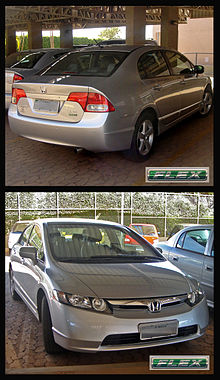 The 2008 Civic LXS Flex is sold in Brazil with a flex-fuel engine capable of running on either gasoline or ethanol or any blend of both.
The 2008 Civic LXS Flex is sold in Brazil with a flex-fuel engine capable of running on either gasoline or ethanol or any blend of both.
While the Civic is sold in largely the same form worldwide, differences in the name of the models exist between markets. In Japan, the hatchback Civic is just called "Civic" while the sedan model was called the (Japanese: Civic Ferio) during the fifth to seventh generations. The sixth-generation sedan was also sold as the Integra SJ. In Europe and the United States, "Civic" generically refers to any model, though in Europe the coupe is branded the "Civic Coupe". A four-door station wagon model called the Civic Shuttle (also Civic Pro in Japan) was available from 1984 until 1991 (this brand name would later be revived for the mid-1990s Honda Shuttle people carrier, known in some markets as the Honda Stream). In South Africa, the sedan (the only model sold there until the 1996 launch of the sixth generation sedan and hatch) was known as the Ballade.
Other models have been built off the Civic platform, including CR-X, Quint, Concerto, Domani, CR-X Del Sol, Integra, and CR-V.
Also, at various times, the Civic or Civic-derived models have been sold by marques other than Honda – for example, Rover sold the 200, 400 and 45, each of which were Civic-based at some point (first 200s were the second generation Ballade; from 1990 the 200 and 400 were based on the Concerto; the 400 was the 1995 Domani), as was their predecessor, the Triumph Acclaim, based on the first Honda Ballade. The Honda Domani, an upscale model based on the Civic, was sold as the Isuzu Gemini in Japan (1992–2000), and confusingly the 5-door Domani was sold as the Honda Civic (along with the "real" hatchback and sedan Civics) in Europe from 1995 to 2000. In Thailand, the sixth generation Civic was available as the four-door Isuzu Vertex. The sixth-generation station wagon was sold as the Honda Orthia, with the Partner as the downmarket commercial variant. The seventh generation minivan model is called the Honda Stream. In Canada, the sixth and seventh generation Civics were mildly redesigned to create the Acura EL until the advent of the eight generation Civic, which was used to create the Acura CSX, which was designed in Canada. Honda Japan adopted the CSX styling for the Civic in its home country.
The three-door hatchback body style has been somewhat unpopular in the United States, but has achieved wide acceptance in Canada, as well as popularity in Japan and European markets, helping cement Honda's reputation as a maker of sporty compact models. Starting in 2002, the Civic three-door hatchback has been built exclusively at Honda's manufacturing plant[dead link] in Swindon, England - previously the five-door "Civic"/Domani and the Civic Aerodeck (based on the Japanese Orthia) were built in this plant for sale in Europe along with the Japanese Civics. Accordingly, all instances of the current model (left or right hand drive, anywhere in the world) are British-made cars designed with Japanese engineering, except for the US-built two-door coupe and the sedan version built in Brazil for the Latin American market.
In North America, the Civic hatchback was dropped for 2006. The 2006 model year standard Civics for North America are manufactured in Alliston, Ontario, Canada (sedans, coupes and Si Coupes) and East Liberty, Ohio (sedans), while the Hybrid version is manufactured in Japan.
In Brazil, although being considered for local manufacturing since the early 1980s (it was illegal to import cars in Brazil from 1973 until 1990), the Civic wasn't available until 1992, via official importing. In 1997, production of the sixth generation Civic sedan started in the Sumaré (a city near Campinas, in the state of São Paulo) factory. The only differences between the Japanese model and the Brazilian model were a slightly higher ground clearance, due to the country's road conditions and adaptations to make the engine suitable to Brazilian commercial gasoline, which contains about 25% ethanol (E25). The seventh generation production started in 2001, displacing the Chevrolet Vectra from the top sales record for the mid-size sedan segment, however it lost that position to the Toyota Corolla the following year. In 2006, the eighth generation was released and regained the sales leadership. Identical to the North American version, it lacks options such a moonroof, and standard security equipment like VSA and side and curtain airbags were removed due to lack of car safety laws in the Mercosur. Furthermore, the Brazilian subsidiary began producing flex-fuel versions for the Civic and the Fit models, capable of running on any blend of gasoline (E20 to E25 blend in Brazil) and ethanol up to E100.[25]
Safety
USA
The National Highway Traffic Safety Administration (NHTSA) in the USA has determined frontal crash test ratings of Honda Civics of different model years.[26]
Model year Make Model Type Curb weight (lb) Frontal driver rating Frontal passenger rating Side Driver passenger rating Side Rear passenger rating 1979 Honda Civic 2-DR 2,166 

1980 Honda Civic 2-DR HBK 2,298 

1981 Honda Civic 2-DR HBK 2,160 

1981 Honda Civic 4-DR HBK 2,456 

1984–1987 Honda Civic 2-DR 2,311 

1984–1987 Honda Civic 4-DR Wagon 2,510 

1988-1989? Honda Civic 2-DR 2,542 

1990?-1991 Honda Civic 4-DR 2,252 

1992–1993 Honda Civic 2/4-DR 2,348 

1994–1995 Honda Civic 2-DR 2,498? 

1994–1995 Honda Civic 4-DR 2,317 

1996–1997 Honda Civic 2-DR 2,337 

1996–1997 Honda Civic 4-DR 2,313 



1998–2000 Honda Civic 2-DR 2,313 



1998–2000 Honda Civic 4-DR 2,379 



2001–2005 Honda Civic 4-DR w/+w/o SAB 2,522 



2001–2005 Honda Civic 2-DR w/o SAB 2,502 



2001–2005 Honda Civic 2-DR w/SAB 2,502 



2002–2005 Honda Civic 2-DR HBK w/o SAB 2,502 



2006–2011 Honda Civic 2-DR w/SAB 2,640 



2006–2011 Honda Civic 4-DR w/SAB 2,749 



The current eighth-generation Civic sedan's crash test performance has been rated highly by both the US Government's NHTSA[27] and the Insurance Institute for Highway Safety. The IIHS awarded the Civic sedan with a rating of "Good" on both frontal and side impact crash tests[28] and lists the Civic as the second-best 2007 small car in overall crashworthiness.[29] The Civic coupe is rated "Acceptable" in the side impact test.[30]
National Highway Traffic Safety Administration (NHTSA) Crash Test Ratings[27]
Honda Motor Co said on Friday July 31, 2009 that it is recalling 440,000 vehicles sold in the US, including some of its best-selling Accord and Civic models for a potentially lethal airbag defect.[31]
Honda said that the airbag inflators in some of its top-selling sedans can rupture because of too much air pressure causing metal fragments to shoot through the airbag and strike vehicle occupants.
One fatality and a number of injuries have been linked to the defect, Honda spokesman Sage Marie said.
The recall covers certain 2001 and 2002 Accords, 2001 Civics and some 2002 and 2003 model Acura TL sedans. The inflator for the driver's side airbag is the defective component on the affected vehicles.
Honda said owners of those models can check to see if their vehicle is covered by the recall by checking the automaker's website at www.owners.honda.com/recalls.
The Japanese automaker said it was encouraging owners to wait until they received a recall notice to go to a dealership and have the inflator for the steering-wheel airbag replaced.
Honda had originally announced that it would recall some 2001 Accord and Civic sedans for the defect in November 2009. Since that time, Service Bulletin 08-093 has been expanded to cover several VINs in the 2001-2002 Accord coupe and sedan, the 01-02 Civic coupe and sedan, one 2003 Civic, the 02-03 CRV, the 2002 Odyssey, and one 2003 Pilot.
Australia
In Australia, 1984–2005 Civics were assessed in the Used Car Safety Ratings 2006 on their level of occupant protection regardless of size or era.[32]
- (1984–1987) - "significantly worse than average"
- (1988–1991) - "average"
- (1992–1995) - "average"
- (1996–2000) - "better than average"
- (2001–2005) - "average"
Modifications and the enthusiast community
Despite being a front wheel drive economy car, the Civic is popular as a platform for modification and customization by an enthusiast community. Starting with the fourth generation and continuing through the 2000 model year, Civics had front double wishbone suspension. Because of parts interchangeability, many Civics which were originally equipped with lower-power engines can later be equipped with a newer Honda engine (a process called engine swap), or many other upgrades.[33] The most common swaps are B16A(Civic SI), B18C(Acura Integra GSR), or the new powerful K20(06-present Civic SI, 02-06 RSX Type-S).
Most recent seventh and eighth generations, now rated as compacts rather than subcompacts, are still competitive as tuner projects. However, they have succumbed to added weight, and higher centers of gravity which has significantly reduced their appeal amongst passionate drivers. Particularly unwelcome among the tuner community[34] was the replacement of the front double-wishbone suspension with MacPherson struts, which provide inferior handling and do not allow dynamic camber angle control.[35][36]
Awards
From 1972 to 1974, the Civic was awarded "Car of the Year Japan." In 1973, the Civic ranked third in the European Car of the Year awards, the highest ranking for a Japanese vehicle at that time. It also was awarded the U.S. Road Test magazine's "1974 Car of the Year."[37] The Civic was the Motor Trend Import Car of the Year for 1980[38] as well as its 2006 Car of the Year. In 2006, the Civic earned the 2007 "Semperit Irish Car of the Year" title. In 1996, Automobile Magazine honored the Civic as its Automobile of the Year. The Civic has been on Car and Driver magazine's yearly Ten Best list six times, in 1985, 1988–91, and 1996. The Civic GX, a natural gas version of the vehicle was named Greenest Car of 2005 by the American Council for an Energy Efficient Economy. Honda claimed 5 of the top 10 Greenest car slots, 3 of which were models of the Civic.[39] The Civic Si was named "Best New Sport Car" and the sedan was named "Best New Economy Car" in the 2006 Canadian Car of the Year awards. The Civic also won the North American Car of the Year and the North American International Auto Show (NAIAS) Car of the Year awards for 2006. In November 2006, the Civic received the prestigious "Car of The Year" award from Brazilian magazine Auto Esporte. The four-door Civic VXi sedan won the South African Car of the Year award for 2007.
Racing
Touring car racing
Civics have been used for racing ever since their introduction. In 1973, a Civic was entered, alongside cars of much larger engine sizes, in the Australian Bathurst 1000 endurance race.
In recent years the Civic has been used in a wide variety of racing series, particularly in Japan. It is also used in touring car races in Europe and the United States. The Civic has been used in the UK in endurance series by teams such as Barwell Motorsport and Cartek Motorsport.
In 2002 JAS Motorsport entered the European Touring Car Championship (ETCC) with a Super 2000 spec Civic and was used until restart season of the World Touring Car Championship (WTCC) in 2005.
In December 2005, on the date of the new 2006 Civic Si's launch in the USA, Honda's R&D Engineering Team completed 645 laps in an 8th generation Civic Si coupe (FG2) to place first in the E1 class of the famous '25 Hours of Thunderhill' marathon race. The drivers on Honda's team were Road & Track journalist Kim Wolfkill, Lee Niffenegger, Chad Gilsinger, Sage Marie, John Sherk, Rich Hays, Andrew Frame, Matt Staal and Car and Driver journalist Tony Swan.[40]
BTCC
In the UK, the Civic has been used in the British Touring Car Championship (BTCC) for several years and is still highly competitive. The Civic made its debut in the 2002 season with the 'Works' team ran by Arena Motorsport. Built to BTC-T specifications, it gained the team 3rd in the manufacturers championship. In the same year Synchro Motorsport won the BTCC Production Teams Championship with a pair of Civic Type R's.
The 2003 season saw the 'works' team Civics secure an impressive 2nd in the manufacturers championship. The 2003 BTCC Production Teams Championship also went to the Civic again, this time in the hands of Barwell Motorsport.
Such was the competitiveness of the Civic in its first two season, 2004 saw five teams enter Civics, allowing the model to secure 2nd in the manufacturers championship.
Although manufacturer support, from Honda, for the BTCC ended in 2005, several teams still found success running the Civic in 2005 and 2006.
For the 2007 BTCC season, Team Halfords ran the new eighth generation Honda Civics, built to the latest S2000 regulations, for Matt Neal and Gordon Shedden with limited success and continued to use the Civic into the 2008 and 2009 season. In both 2007 and 2008, the Civic allowed the team to finish 3rd in the Teams championship, behind the two manufacturer backed teams.
In 2010 Honda returned to the BTCC as a 'works' team with Team Dynamics using Civics to win the 2010 manufactuers championship.[41]
In 2011 the team returns with its Civic to defend its Team and Manufactuers championship agin with the Neil and Shedden pairing.
Honda Racing Team will swap to the brand new ninth generation Honda Civic, built fully to NGTC rules, for the 2012 BTCC season. They are the first manufacturer backed team to announce their intention to run fully to the NGTC specification.[42]
Drag and street racing
With the huge availability of modification parts to make the Civic quicker and its popularity in street racing, the Civic has become a popular choice for sports compact drag racing, where in the United States, it has helped to launch the career of numerous drag racers such as Ron Sharman, Kenny Tran, Jacob Abercrombie, Lisa Kubo, and J.D. Eisenhart.[43]
Grassroots racing
In autocross, the low, wide, sub-2,000 pound 1988-1991 Civic Si hatchback (notably the 1989 model year) has been dominant in SCCA Solo ST (Street Touring, previously Street Touring Sedan) class for a number of years. For example, 1988-1991 Civics captured all of the top 20 positions at the 2009 national finals. In 10 Nationals since the ST became a national class in 2001, the Civic Si has taken nine out of 10 Men's titles and seven out of 10 Ladies' titles.[44]
References and footnotes
- ^ "History of Civic First Generation". Honda. http://world.honda.com/CIVIC/generation01/.
- ^ "Generations". Edmunds. http://www.edmunds.com/insideline/do/Features/articleId=68272. Retrieved 2006-11-05.[dead link]
- ^ "2006 Honda Civic Expert Review". Cars.com. http://www.cars.com/go/crp/research.jsp?revid=49131&indcriteria=ASSET_TYPE-Affiliate+Review%2CBuying+Guide%2CVehicle+Profile%7CM-_18_%7CD-_214_%7CY-_2006_%7CresultStructure-combined&makeid=18&modelid=214&year=2006&myid=&revlogtype=19§ion=reviews&mode=&aff=national.
- ^ "2006 Honda Civic Review". JB car pages. http://www.jbcarpages.com/honda/civic/2006/. Retrieved 2008-08-02.
- ^ a b Collier, Joe G. (2006-06-01). "Honda getting its groove back with Civic". Detroit Free Press. http://www.usatoday.com/money/autos/2006-05-24-civics_x.htm. Retrieved 2011-10-16.
- ^ Duarte, Joe (2011-01-05). "Canada's most popular car 13 years running". Autonet.ca. http://www.autonet.ca/autos/news/2011/01/05/16770011-autonet.html. Retrieved 2011-10-16.
- ^ Krisher, Tom (2010-08-19). "Why Honda is growing as Detroit falls behind". SFGate. http://www.sfgate.com/cgi-bin/article.cgi?f=/c/a/2008/07/03/BUUM11IVF4.DTL&type=autos. Retrieved 2011-10-16.
- ^ "Fuel-efficiency pays off for Honda". Washington Times. 2009-09-19. http://www.washingtontimes.com/news/2008/sep/19/fuel-efficiency-pays-off-for-honda/. Retrieved 2011-10-16.
- ^ Takahashi, Yoshio (2010-11-16). "Honda to End Civic Sales in Japan". The Wall Street Journal. http://online.wsj.com/article/SB10001424052748704312504575617920923449974.html?mod=googlenews_wsj. Retrieved 2010-12-28.
- ^ "Old School Hondas 1960's - 80's". www.1stgencivic.org. http://www.1stgencivic.org/index.html. Retrieved 2010-10-23.
- ^ Goodman, Richard M. (1983). Automobile design liability, Volume 1. Center for Auto Safety, Lawyers Co-operative Publishers. p. 106.
- ^ "Vehicle Recalls, NHTSA Campaign: Honda Civic". allworldauto.com recalls. http://www.allworldauto.com/recalls/NHTSA_81V136000_1979_HONDA_CIVIC_recall_1179.html. Retrieved 2011-10-16.
- ^ Ditlow, Clarence; Gold, Ray (1994). Little secrets of the auto industry: hidden warranties cost billions of dollars. Moyer Bell. p. 84. ISBN 9781559210850.
- ^ Dunne, Jim (December 1981). "Detroit Report". Popular Science 219 (6): 8. http://books.google.com/books?id=XBZpIPL1lloC&pg=PA8&dq=Consent+order++Honda&hl=en. Retrieved 2011-10-16.
- ^ "Updates". Car and Driver 28: 27. 1982.
- ^ "Generations". Edmunds. http://www.edmunds.com/insideline/do/Features/articleId=68272. Retrieved 2006-11-05.[dead link]
- ^ "Inside Line: News, Road Tests, Auto Shows, Car Photos and Videos". Edmunds.com. http://www.edmunds.com/insideline/do/Features/articleId=68272. Retrieved 2010-10-24.[dead link]
- ^ "2003 Honda Civic Review". JB car pages. http://www.jbcarpages.com/honda/civic/2003/. Retrieved 2356-03-06.
- ^ "2003 Honda Civic Hybrid Review". JB car pages. http://www.jbcarpages.com/honda/civic/2003hybrid/. Retrieved 2009-03-06.
- ^ "Facelifted 2009 Honda Civic Sedan gets scantastic reveal". Autoblog. http://www.autoblog.com/2008/08/17/facelifted-2009-honda-civic-sedan-gets-scantastic-reveal/.
- ^ "2009 Honda Civic Review". JB car pages. http://www.jbcarpages.com/honda/civic/2009/. Retrieved 2009-03-06.
- ^ Omar Rana (2011-04-05). "Honda targeting 12% increase in April sales despite vehicle shortages". egmCarTech. http://www.egmcartech.com/2011/04/05/honda-targeting-12-increase-in-april-sales-despite-vehicle-shortages/.
- ^ "Honda Civic Si Concept coupe and Civic Concept sedan debut at NAIAS; hybrid and natural gas variants". Green Car Congress. 2011-01-12. http://www.greencarcongress.com/2011/01/civic-20110112.html.
- ^ "Honda Study Finds Insight's Eco Assist System Results in Average 10% Improvement in Fuel Economy After 300 Drives, Up to 20% Max". Green Car Congress. 2010-02-12. http://www.greencarcongress.com/2010/02/honda-study-finds-insights-eco-assist-system-results-in-average-10-improvement-in-fuel-economy-after.html.
- ^ "Honda Civic atinge 300 mil unidades produzidas" (in Portuguese). Honda Brazil. September 2008. http://www.honda.com.br/web/index.asp?pp=noticias&ps=noticia&ps2=carros&id=1564. Retrieved 2008-09-07.[dead link]
- ^ "NHTSA Crash Test Results For 1997 US NCAP". SafeCarGuide.com, Inc.. http://www.safecarguide.com/exp/archive/archive.htm#anchor359532. Retrieved January 2, 2009.
- ^ a b "Honda Civic Crash Test Ratings". NHTSA. http://www.safercar.gov/portal/site/safercar/menuitem.94b0130be143aeb342252f0835a67789/?vgnextoid=68adf2905bf54110VgnVCM1000002fd17898RCRD. Retrieved 2008-08-02.[dead link]
- ^ "IIHS-HLDI: Honda Civic". IIHS. http://www.iihs.org/ratings/ratingsbyseries.aspx?id=300. Retrieved 2007-06-09.
- ^ "IIHS-HLDI: Small cars - Current". IIHS. http://www.iihs.org/ratings/summary.aspx?class=40. Retrieved 2007-06-09.
- ^ "IIHS-HLDI: Honda Civic 2-door". Iihs.org. 2009-07-21. http://www.iihs.org/ratings/rating.aspx?id=1119. Retrieved 2009-08-23.
- ^ "Honda recalls 440,000 cars for airbag risk". Reuters. 2009-07-31. http://www.reuters.com/article/idUSTRE56U5HH20090731. Retrieved 2011-10-16.
- ^ "Used Car Safety Ratings". Vic Roads. http://www.vicroads.vic.gov.au/ucsr. Retrieved 2006-11-05.
- ^ "Honda Civic Customization". CustomCivics.com. http://www.customcivics.com.
- ^ "Has Honda Lost Its Way?". insideline.com. http://blogs.insideline.com/straightline/2010/05/has-honda-lost-its-way.html.
- ^ "How Car Suspensions Work". howstuffworks.com. http://auto.howstuffworks.com/car-suspension4.htm.
- ^ "Suspension Design: Types of Suspensions". www.automotivearticles.com. http://www.automotivearticles.com/123/Suspension_Design_Types_of_Suspensions.shtml.
- ^ "First Generation (1972)". Honda Worldwide. http://world.honda.com/CIVIC/generation01/. Retrieved 2006-11-05.
- ^ "Second Generation (1972)". Honda Worldwide. http://world.honda.com/CIVIC/generation02/. Retrieved 2006-11-05.
- ^ "A Red-Letter Year for Green Vehicles: Gasoline-Powered SUV Earns Spot on "Greenest Vehicles of 2005" List". Greenercars. http://www.greenercars.com/pr11.html. Retrieved 2006-11-05.
- ^ Waterman, Stuart (2005-12-06). "Honda Civic Si scores class win in 25 Hours of Thunderhill – Autoblog". Autoblog.com. http://www.autoblog.com/2005/12/06/honda-civic-si-scores-class-win-in-25-hours-of-thunderhill/. Retrieved 2010-10-24.
- ^ "Honda sticks to a winning team". btcc. 2010-10-22. http://www.btcc.net/html/generalnews_detail.php?id=2180&month=0&year=2010. Retrieved 2011-06-17.
- ^ "All new Civic for 2012". British Touring Car Championship (TOCA). 01 September 2011. http://www.btcc.net/html/generalnews_detail.php?id=2598. Retrieved 01 September 2011.
- ^ "Honda Civic 1996-2000 Ultra Racing 4-Point Mid Lwr". Nextgentuning.com. http://www.nextgentuning.com/infoProdVehicle/Ultra-Racing-4-Point-Middle-Lower-Bars/1822/1553/Default.aspx. Retrieved 2010-07-12.[dead link]
- ^ National Solo Rules[not in citation given]
External links
« previous — Honda road car timeline, 1980s–present 1980s 1990s 2000s 2010s 0 1 2 3 4 5 6 7 8 9 0 1 2 3 4 5 6 7 8 9 0 1 2 3 4 5 6 7 8 9 0 1 kei truck
MicrovanActy/Street Acty/Street Acty/Vamos Kei car Today Today Life/Honda Z Life/Zest Life/Zest Subcompact City/Jazz City City/Logo/Capa Fit/Jazz/City/Aria/Mobilio Fit/Jazz/City/Aria/Freed Ballade Ballade Concerto Domani Civic Civic Civic Civic Civic/Orthia/Partner Compact Quint Civic/EL Civic/CSX Accord Accord/Vigor Accord/Vigor Accord Accord/Ascot Mid-size Accord/Ascot Accord/TL/TSX Inspire/Vigor Inspire/Saber/Rafaga Inspire/Saber/Torneo Inspire/Accord Insight Full-size Inspire/Accord Legend Legend Legend/RL Legend/RL Legend/RL Coupé CRX CRX del Sol Insight CR-Z Integra Integra Integra Integra Prelude Prelude Prelude Prelude Prelude Sports Beat S2000 NSX Mini SUV HR-V Crossroad Compact SUV Passport Compact Crossover SUV Element CR-V CR-V CR-V/RDX Mid-size CUV Crossroad Pilot Pilot Luxury CUV MDX MDX Compact MPV S-MX Edix/FR-V Stream Stream Avancier Airwave/Partner Minivan Stepwgn Stepwgn Stepwgn Odyssey Odyssey/LaGreat Odyssey Odyssey Odyssey (JDM) Odyssey (JDM) Odyssey (JDM) Elysion Pickup Ridgeline Honda road car timeline, North American market, 1980s–present Type 1980s 1990s 2000s 2010s 0 1 2 3 4 5 6 7 8 9 0 1 2 3 4 5 6 7 8 9 0 1 2 3 4 5 6 7 8 9 0 1 2 Subcompact Insight Civic Civic Civic Civic Civic Fit Fit Compact Insight Accord Accord Accord Accord Civic Civic Civic Mid-size Accord Accord Accord Accord Coupe Crosstour Full-size Accord Sedan Coupe Prelude Prelude Prelude Prelude Prelude Sport compact CR-X CR-X del Sol CR-Z Sports car S2000 SUV Element CR-V CR-V CR-V CR-V Passport Passport Pilot Pilot Pickup truck Ridgeline Minivan Odyssey Odyssey Odyssey Odyssey TC 2000 Championship Seasons Current cars (2011) Chevrolet Cruze • Fiat Bravo • Honda Civic Si • Toyota Corolla • Renault Fluence • Volkswagen Golf • Volkswagen Polo • Ford Focus • Peugeot 307Current circuits Córdoba • General Roca • Oberá • Jorge Ángel Pena • Río Hondo • Resistencia • Santa Fe • Buenos Aires • Centenario • Punta del Este (Uruguay) • Eduardo Copello • San LuisFormer circuits Bahía Blanca • Comodoro Rivadavia • Güemes • Curitiba (Brazil) • Interlagos (Brazil) • Paraná • ViedmaCategories:- Honda vehicles
- Honda Civic
- Vehicles with CVT transmission
- Front wheel drive vehicles
- All wheel drive vehicles
- Compact cars
- Subcompact cars
- Motor vehicles manufactured in the United States
- 1970s automobiles
- 1980s automobiles
- 1990s automobiles
- 2000s automobiles
- 2010s automobiles
- Coupes
- Hatchbacks
- Sedans
- Station wagons
- Road vehicles manufactured in the United Kingdom
- Vehicles introduced in 1973
Wikimedia Foundation. 2010.

